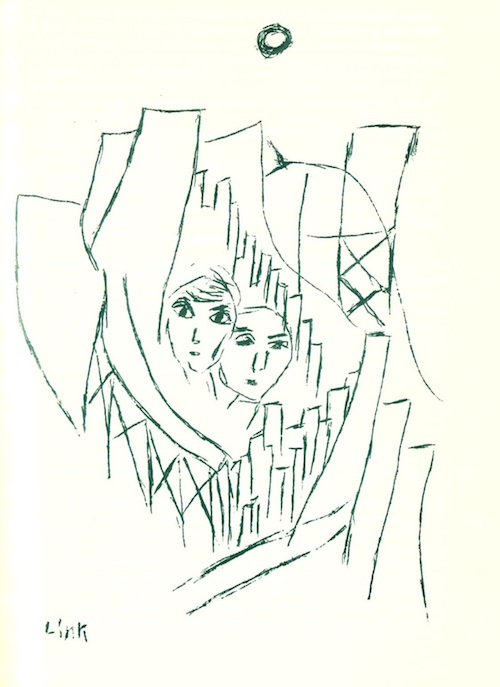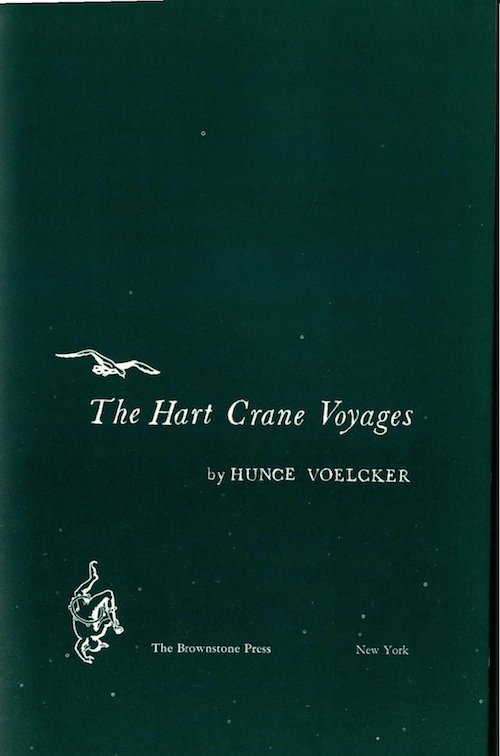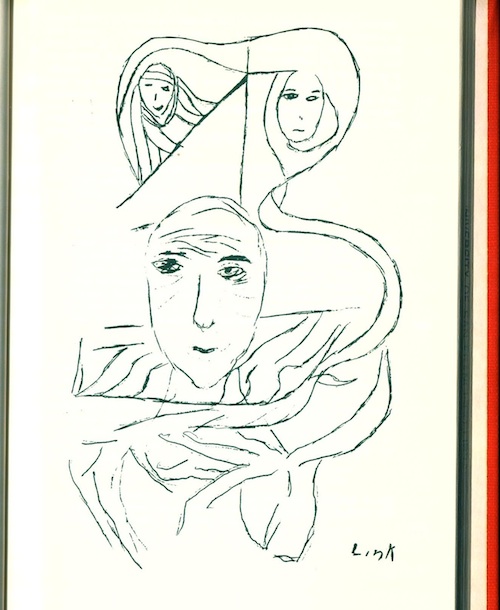T H E D I S T A N C E S and / or C I T I E S (8)

… language as it is embodied, perpetually being created. Composition takes place in the liminal moment of history-in-the-making, at the ‘rim of occurrence’ (Leslie Scalapino). We compose ourselves, our locus, as we make knowledge, but what we generate as writers partakes in a dance with the embodiment of our readers.
—Joan I. Goodman
I feel as though I became aware of poet Leslie Scalapino from the minute I hit San Francisco to study Poetics at New College. Having missed the opportunity to work with Lyn Hejinian, I've always taken full advantage of attending readings and other events by poets I wasn’t having the advantage of hearing in the classroom, such as Scalapino or Hejinian. I sought to soak up the ambient textures which only arrive during in-person engagement when the sound of words delivered from out the physical body is indelibly etched into air. Being present in the moment at such times is unforgettable. Witnessing how a poet like Scalapino held herself, her manipulation of vocal inflections, pauses and various other personal traits was quite striking.
A few years ago I reviewed Leslie Scalapino ’s How Phenomena Appear to Unfold (Litmus Press 2010) for Eileen Tabios’s stellar Galatea Resurrects, at the start of the review I rather breezily remark “I’ve never much cared for Leslie Scalapino’s poems and often found her public appearances extremely trying.” In retrospect this is more than a bit cheeky, but I was daunted by confronting the task of writing about such engaging critical creative work. I sought an entrance into discussing it, to at once introduce my familiarity with Scalapino while also making clear my feeling of distinct ambivalence, even leaning towards disgruntlement, with which I approached reading—let alone writing on her work. Although of course it was I who had requested to review the book!
I had in fact expected to find her book as fully rewarding as I did. As I enthusiastically state:
Scalapino’s passionate dedication to poetry: articulate, troublesome (as well as usefully troubled) is daring and lives comfortably within itself. Alive in rich exchange of ideas and feelings together, Scalapino crucially thinks with her body in writing. She delves into crossways where otherwise divergent paths of mind, soul, spirit, and heart are to be witnessed brought together. It’s a precision tinged challenging of historical orders of thought, particularly those of Occidental origin. It is poet’s work: a life work. Brilliant and energy giving: generously demanding. You should read her.
How Phenomena is both an expansion and re-working of the previous edition of the same title published by Potes and Poets in 1989, as Scalapino writes in her preface, the writing “is conceived as an ongoing, flexible structure that incorporates demonstrations of its gestures, such as poem-plays and poem-sequences alongside essays.” This kind of writing is exactly the sort of creative critical gesture I adore reading. She states that her intent is to have “the unfolding structure of the book mime and demonstrate—be (and be seeing) the process and the instant of—the inside and the outside simultaneously creating each other.” As a result, the conversation between reading and writing is internally resonant within the text. Writing reading comes to mirror reading writing.
I am most particularly happy to have corrected my utterly inaccurate perception of her relationship to the work of Philip Whalen:
Philip Whalen is a central re-occurring poet whose work Scalapino turns to as mirror to her own. While her take on Whalen may often be arguably self-serving, it is not the “nonsense” I am previously guilty of having been in agreement with a fellow poet of finding it to be. Her extrapolation of “Whalen’s view that the poem precedes thinking” is quite of use in digging beneath Whalen’s somewhat commoner appearing surfaces, too often his own humbleness allowing for his work to evade such deep penetration of its brilliance. Scalapino locates our awareness to instances where Whalen clearly demonstrates that “the poem thinks itself, being ahead of the person” as she strives towards articulating her own practice of the poem as entity in the process of its creation. Like Whalen, she would relinquish her control over writing in order that the writing acts on its own; that, no matter whatever else, it finds its own way. As she writes of her own work, “it is phenomena as being one’s mind. ‘Seeing’ is not separate from being action and these are only the process of the text/one’s mind phenomena. Writing is therefore an experiment of reality.” And commenting on Whalen’s work, again: “The poem is one’s always leaping out of one’s mind, not being in the same moment of one’s mind there.”
I remain swept away by how fluidly Scalapino shifts between levels of hyper-critical discussion with whirling gyres of vocabulary to relatively simple statement, even leaning towards a New-Agey spiritualism I usually cringe at. Yet her discussion of Whalen’s work, hinging as does upon the dual nature of the writing reading business, which has proved elemental to my own concerns, ranks Scalapino in the company of figures such as Robert Duncan and Whalen himself in my own Poet House of Influence.
Scalapino practices some real witch-talk, mapping consciousness without end. Three essential lessons I see as framing the body of her critical creative work: 1) ask the questions nobody else is asking 2) accept the conditions into which those questions lead and 3) follow your own integral coordinates. I take these to heart myself and always keep an ear out for works previously unknown to me exploring territory I myself favor.
One April, poet Neeli Cherkovski emailed out a poem of his own entitled “ECSTATIC PRAYER in memory of Hunce , author of The Hart Crane Voyages.” Having never heard of Hunce Voelcker—but always an enthusiastic reader of all things Hart Crane—I became immediately intrigued. Since I was at work, and have the luck to be employed at a university library with an often incredibly above average poetry collection, I went upstairs and pulled Voelcker’s book off the shelf. Published in 1967 by The Brownstone Press, with a green cover and printed in green ink throughout, the slim volume deftly dispenses a healthy heft of raw poetics.

There are blurbs from Robert Duncan and Crane scholar/biographer John Unterecker beneath the floating image of a gull with outspread wings. Duncan declares Voelcker’s book to be
…a bridge between us and Hart Crane’s life in poetry and in love. Deep studies, not only in Crane’s works and letters and in the whole field of literary criticism related, but also in mythopoetic lore, inform Voelcker’s work; but what makes the book unique is the magic of an affinity which informs it.
[…]
Ardent, rare, inspired, the book is a true companion to the work it addresses.
Unterecker is no less generous, if more informative in conveying some of the factual aspects regarding Voelcker's approach to writing on Crane's poem:
…his object is not really to talk “about” the public poem at all but rather to give us an imagined account of its genesis. What Voelecker does is to project himself into Crane’s mind, attempting to reconstruct for us something of the process of feeling that Crane experiences both as he falls in love and as he turns that love into poetry.
[…]
Neither biography nor criticism, Voelecker’s book offers us one man’s version of another man’s soul—for me, convincingly.
This is one of those rare widely unknown gems among poet-books. A text wherein one poet’s own writing willingly yields to the interests discovered in the course of diving full throttle into the work of another poet. Voelcker imagines Crane’s mental and spiritual state surrounding the writing of his poem “Voyages” sparked by Crane’s tumultuous, passionate relationship with the Danish sailor Emil Opffer. The ocean is a recurring motif throughout the poem.
Voelcker describes how “one may discover Poe, Whitman, Baudelaire, Samuel Greenberg, Rimbaud, the poet’s body and the ashes of his mother” in the richly aural and textual nature that is brought on by all the ocean imagery. Voelcker constructs his commentary by weaving in works by those poets he mentions above as well as others, along with utilizing Crane’s own words from letters and the biographical accounts of his friends and associates. Throughout his study he presents strong mythological strains of allusion. These references arrive stacked throughout his text, impressing with amalgamative force but never too distracting or intimidating.
This is precisely the sort of book I hold most dear. Voelecker is so far immersed in Crane’s poem that the roles of reader and writer merge into a whirling roulette-spin of pages. Mentorship is part—but never all—of such a book. The poet composes not only in tribute, but out of personal need. The work quickly becomes a ritual exploration of paths others have followed where lines of correspondence between other poems and authors pop up in a continuous stream of inter-textual crosshatching. More than anything, such books serve as touchstones revealing how poetry functions as the act of inexorably mixing together one's writing and reading. There is no exegetical information to be studied and learned. There is but the experience of the book itself.
Olson’s Ishmael, Howe’s Dickinson, Duncan’s H.D., Zukofsky’s Bottom are all obvious examples, but I would also include Wieners’ 707, Coolidge’s Jazz, Notley’s Heiresses, and Kerouac’s Dharma: all texts by fabulous poets offering instruction in poetics in a manner unlike any other. Yet Voelcker's book stands distinctly apart from such company. Primarily because his Voyages deserves to remain essential reading by anybody interested in Crane or American Poetry while none of his other books stand much chance of finding a lasting, broad readership. He is an undeniably minor poet who yet successfully seized the opportunity of contributing an as yet still overlooked major work on a one of the singularly unique poets of our time.
Cherkovski’s poem to Voelcker opens “just now hanging around/thinking of your pyramid house/and the Hart Crane Voyages” continuing on “North Marin the meadows/and woods and meadows/and nearby Redwood Preserve/where we walked ecstatic/dancing middle aged queens.” Voelcker, a poet of Marin County north of San Francisco, was involved in the heady and colorfully liberated politics and poetics of the 60s/70s local poetry scene. Along with palling around in poet circles with Cherkovski, he was also close friends with both Rich Tagett and Andrei Codrescu.
Later in his poem, Cherkovski marvels: “Hart Crane/his hair combed back from the forehead/sensual gentle lips/small eyes a large face/hands yes hands in handsome poems.” These lines are not only in conversation with Voelcker’s deeply personal text but also the accompanying line drawings in the book which are by the artist identified only as “Link.”

After reading Cherkovski's poem I responded with some lines of my own, indebted and addressed to Crane and others:
Hart hang up the assemblage
of self
with dreamers
yet to come
one vast stylized drama
rocky cliff face washes
dream meeting with Jeffers
no two more stubborn men
grace to have
the work
keeps us toiling
a measured span of what's left
undone
insult fury abides nothing less
I had not yet pulled Voelcker's Voyages and was thinking of Cherkovski’s poem in relation to Creeley's poems, “Hart Crane 2” and “Hart Crane,” along with Wieners' "Hart Crane, Harry Crosby," also Cherkovski's clear references to California locales had brought Robinson Jeffers to mind; however, in reading Voeckler’s book I do find my initial responses to Cherkovski’s poem fully reflected back in his imagined retelling of Crane’s poem. Voelcker tackles Crane with just the right amount of needed immediacy and intuited erudition, engaging with Crane's work on the most intimate of levels. My own poetic mythos surrounding Crane stands enlarged upon. I am in his debt in the purest, simplest and most pleasurable manner.
Patrick James Dunagan was raised a skateboarder in Southern California and became interested in poetry…
Read Full Biography

